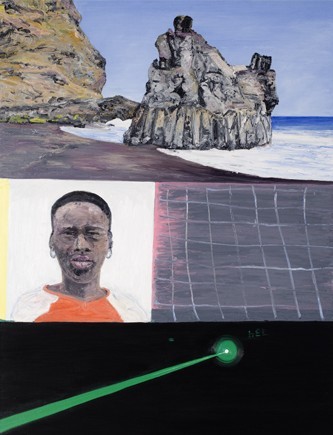Jan van der Pol
24 Apr - 15 Jul 2013
JAN VAN DER POL
Pluriform & Simultaneous
24 April - 15 July 2013
Jiri Svestka gallery is proud to present works by Dutch painter Jan van der Pol for the first time in Czech Republic.
Van der Pol watches, observes and collects. In most of the writing about his work, the author refers himself to his collection of African art and the vast butterfly and beetle collection the artist has had built up around a core collection inherited by his father. Similarly as refering to his collection, he is pointing out the multiplicity, that surround us. But not for romantic or nostalgic reasons, he doesn ́t escape reality. The core of his fascination – which simultaneously reveals fundamental convergence – is perception, watching, observation and empiricism. As well he has a critical interest in technology, nature and science. The interest is informed by a strong affinity by the times we live in. His work is in this context, without any doubt, in compliance with the long and rich tradition of Dutch painting from the golden era of landscape painting to formal experiments of Piet Mondrian and De Stijl.
When Jan van der Pol speaks about formal aspects of painting, he takes, as well as Dutch modernists, into account technical aspects of the viewer ́s conception of the images: when does the discrepancy in colours result in a unified work? how does the eye move across the canvas? when should colour fields be strictly delineated? what happens, when the image blurs? these questions are immanent to his paintings. But of course, there is as well a strongly poetic side to this ordering: the enumeration as an instrument for the aesthetic experience (many times reappeared Lautremonts meeting of an umbrella and a sewing machine).
Surrealism influences Van der Pol ́s art in many ways, deep- drawn from his admiration of collages by Max Ernst. But his main interest doesn ́t lie in the Freudian meanings found in our subconscious. He sees Surrealism as a method for deconstructing text and imagery and creating "new“ narrative opportunities. According to Van der Pol, the Surrealism of the early twentieth century, in terms of breaking the naturalistic imperative, was even more important than Cubism, that had dominated Western painting for so long.
Van der Pol ́s paintings can be seen as a composite of images. However, this composite can also be reduced to a common denominator. Together – various, figrative and abstract elements form a single landscape – a unified image of the world – albeit one that is fragmented and marked by human intervention, even when it presents itself as "nature“.
Works by Jan van der Pol (born 1949, in Netherlands, studied at Rijksacademie, lives and works in Amsterdam, over 25 years of teaching painting and printmaking at The Royal Academy of Fine Arts in Hague) are presented at the most important Dutch and international private and public collections.
Pluriform & Simultaneous
24 April - 15 July 2013
Jiri Svestka gallery is proud to present works by Dutch painter Jan van der Pol for the first time in Czech Republic.
Van der Pol watches, observes and collects. In most of the writing about his work, the author refers himself to his collection of African art and the vast butterfly and beetle collection the artist has had built up around a core collection inherited by his father. Similarly as refering to his collection, he is pointing out the multiplicity, that surround us. But not for romantic or nostalgic reasons, he doesn ́t escape reality. The core of his fascination – which simultaneously reveals fundamental convergence – is perception, watching, observation and empiricism. As well he has a critical interest in technology, nature and science. The interest is informed by a strong affinity by the times we live in. His work is in this context, without any doubt, in compliance with the long and rich tradition of Dutch painting from the golden era of landscape painting to formal experiments of Piet Mondrian and De Stijl.
When Jan van der Pol speaks about formal aspects of painting, he takes, as well as Dutch modernists, into account technical aspects of the viewer ́s conception of the images: when does the discrepancy in colours result in a unified work? how does the eye move across the canvas? when should colour fields be strictly delineated? what happens, when the image blurs? these questions are immanent to his paintings. But of course, there is as well a strongly poetic side to this ordering: the enumeration as an instrument for the aesthetic experience (many times reappeared Lautremonts meeting of an umbrella and a sewing machine).
Surrealism influences Van der Pol ́s art in many ways, deep- drawn from his admiration of collages by Max Ernst. But his main interest doesn ́t lie in the Freudian meanings found in our subconscious. He sees Surrealism as a method for deconstructing text and imagery and creating "new“ narrative opportunities. According to Van der Pol, the Surrealism of the early twentieth century, in terms of breaking the naturalistic imperative, was even more important than Cubism, that had dominated Western painting for so long.
Van der Pol ́s paintings can be seen as a composite of images. However, this composite can also be reduced to a common denominator. Together – various, figrative and abstract elements form a single landscape – a unified image of the world – albeit one that is fragmented and marked by human intervention, even when it presents itself as "nature“.
Works by Jan van der Pol (born 1949, in Netherlands, studied at Rijksacademie, lives and works in Amsterdam, over 25 years of teaching painting and printmaking at The Royal Academy of Fine Arts in Hague) are presented at the most important Dutch and international private and public collections.

